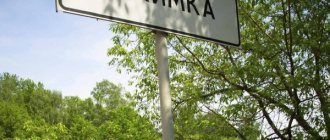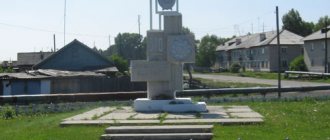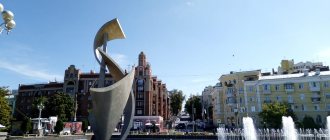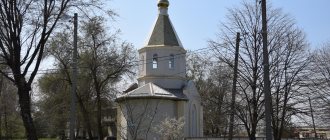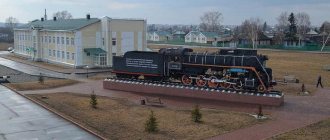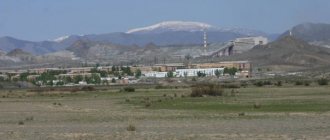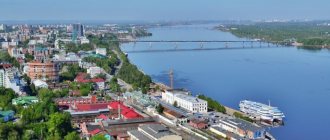City in Novosibirsk region, Russia
For information about other places with the same name, see Bolotny.
City in Novosibirsk region, Russia
| Bolotnoe Bolotnoe | |
| Town[1] | |
| Bolotnaya railway station in Bolotnoye | |
| Flag Coat of arms | |
| Location Bolotnoye | |
| Bolotnoe Location Bolotnoye Show map of Russia Bolotnoe Bolotnoye (Novosibirsk region) Show map of Novosibirsk region | |
| Coordinates: 55°41′N 84°25'E / 55.683°N W. 84.417°E / 55.683; 84.417Coordinates: 55°41′N 84°25'E / 55.683°N W. 84.417°E / 55.683; 84.417 | |
| A country | Russia |
| Federal subject | Novosibirsk region[1] |
| Administrative region | Bolotninsky district[1] |
| Town | Bolotnoye[2] |
| Based | 1805[3] |
| City status from | 1943 |
| Height | 200 m (700 ft) |
| population (2010 Census)[4] | |
| • General | 16,570 |
| • Evaluate (2018)[5] | 15,668 (−5.4%) |
| Administrative status | |
| • Capital from | Bolotninsky district[1], Bolotnoye[2] |
| Municipal status | |
| • Municipal district | Bolotninsky municipal district[6] |
| • Urban village | Urban settlement Bolotnoye[6] |
| • Capital from | Bolotninsky municipal district[7], urban-type settlement Bolotnoye[6] |
| Timezone | UTC + 7 (MSK + 4 [8]) |
| Postal code(s)[9] | 633340, 633343 |
| OKTMO I WOULD | 50606101001 |
Bolotnoe
(Russian: Bolotnoye, lit.
swampy
) is a town and the administrative center of Bolotninsky District in Novosibirsk Oblast, Russia, located 126 km northeast of Novosibirsk, the administrative center of the region. Population: 16,570 (2010 Census);[4]18,170 (2002 Census);[10]20,006 (1989 Census).[11]
The smallest cities of the Novosibirsk region
There are only 14 cities in the Novosibirsk region, so most of them fall into the top 10 small ones in terms of population and territory. There is only one million population - the capital Novosibirsk with a population of 1,612,833 and a territory of 505.62 km². Moreover, it is the third largest city in Russia.
It is even more surprising that in addition to it, there is only one settlement in the region where the number of residents exceeds 100,000. We are talking about Berdsk, where almost 16 times fewer residents live - 103,290. At the same time, it is in seventh place from the bottom in size, which makes it both small and large at the same time.
An even more unusual story is about the small town of Chulym. Surprisingly, in terms of territory size it is closest to Novosibirsk with an indicator of 203 km². However, only 11,270 people live here, which puts it in second place on the list of settlements with the minimum number of citizens. Another large settlement is Kuibyshev with an area of 109.73 km². For other cities this figure does not exceed 81 km².
Top 10 smallest cities in the Novosibirsk region by size (value in km²):
- Cherepanovo - 20.
- Ob - 21.95.
- Iskitim - 29.9.
- Kupino - 32.
- Karasuk - 35.76.
- Bolotnoye - 59.
- Berdsk - 67.
- Barabinsk - 69.48.
- Kargath - 69.
- Tatarsk - 80.
Rating of cities with the smallest population:
- Kargat - 9,516.
- Chulym - 11,270.
- Kupino - 13,781.
- Bolotnoye - 15,626.
- Cherepanovo - 19,612.
- Toguchin - 21,159.
- Tatarsk - 23,956.
- Karasuk - 27,196.
- Barabinsk - 29,122.
- Ob - 29,194.
Bolotnoe
(Novosibirsk region)
OKATO code:
50206501
Founded:
1805
Urban settlement since:
1931
City since:
1943 City of district subordination (Bolotninsky district, Novosibirsk region)
Center:
Bolotninsky district
Telephone code (reference phone)
| 38349***** | 22-1-82 |
Deviation from Moscow time, hours:
4
Geographic latitude:
55°40′
Geographic longitude:
84°24′
Altitude above sea level, meters:
190 Sunrise and sunset times in the city of Bolotnoye
Cherepanovo is the leader of the rating
The smallest town is Cherepanovo, located 73 km from Novosibirsk. Its size is only 20 km², but in terms of population it ranks fifth on the list: 19,612 people live here, 10,000 more than in Kargat, a town with the smallest number of inhabitants.
Cherepanovo was founded in 1912 as a temporary settlement: settlers spent the winter here. Three years later, a railway station opens next to it, giving impetus to development. By 1921 it had grown and received city status, and today it occupies the position of a regional center.
Despite its modest size, industry is quite well developed, which allows it to keep a significant part of local residents from moving: despite the trend of urbanization and growth of megacities, since 1999 the number of citizens has decreased by only 3,500. Among the important enterprises it is worth noting:
- brewery;
- meat processing plant;
- garment factory;
- plant for the production of building materials.
Map
| Bolotnoe: maps |
Bolotnoye: photo from space (Google Maps) Bolotnoye: photo from space (Microsoft Virtual Earth)
| Bolotnoye. Nearest cities. Distances in km. on the map (in brackets along roads) + direction. Using the hyperlink in the distance , you can get the route (information courtesy of the AutoTransInfo website) | |||
| 1 | Yurga | 33 (41) | IN |
| 2 | Station-Oyashinsky | 42 () | SW |
| 3 | Toguchin | 48 (56) | YU |
| 4 | Moshkovo | 63 (73) | SW |
| 5 | Yashkino (Kemerovo region) | 67 (193) | IN |
| 6 | Mountain | 68 () | SW |
| 7 | Kozhevnikovo (Tomsk region) | 70 (241) | WITH |
| 8 | Sokur | 85 () | SW |
| 9 | Fireboxes | 87 (102) | SE |
| 10 | Taiga | 87 (219) | NE |
| 11 | Zonal Station (Tomsk region) | 93 () | NE |
| 12 | Timiryazevskoe (Tomsk region) | 95 (148) | WITH |
| 13 | Tomsk | 99 (140) | WITH |
| 14 | Melnikovo (Tomsk region) | 101 (204) | WITH |
| 15 | Seversk | 107 (160) | WITH |
| 16 | Baryshevo | 110 () | SW |
| 17 | Svetly (Tomsk region) | 110 (167) | NE |
| 18 | Koltsovo | 111 () | SW |
| 19 | Kemerovo | 111 (124) | IN |
| 20 | Anzhero-Sudzhensk | 111 (220) | NE |
| 21 | Kolyvan | 112 (182) | Z |
| 22 | Moryakovsky Zaton (Tomsk region) | 114 () | WITH |
| 23 | Industrial (Kemerovo region) | 114 (200) | SE |
| 24 | Berezovsky | 116 () | Z |
| 25 | Novosibirsk | 117 (135) | SW |
| 26 | Metal site (Kemerovo region) | 119 () | IN |
| 27 | Samus (Tomsk region) | 120 () | WITH |
a brief description of
Located in the southeast of the West Siberian Plain, 126 km northeast of Novosibirsk.
Railway station.
Territory (sq. km): 73
Information about the city of Bolotnoye on the Russian Wikipedia site
Historical sketch
Founded in 1805 as the village of Bolotnoye near the Siberian Highway, from which the road to Barnaul branched off here. Named for its proximity to the swamp.
Workers' settlement since May 10, 1931. City since 1943.
Economy
Enterprises of railway transport and food industry. Garment factory. Production of building materials.
Museums, galleries, exhibition halls
Bolotninsky District Museum of History and Local Lore 633344, Novosibirsk region, Bolotninsky district, Bolotnoye, st. Zababonova, 1a Phone(s): (38349) 25-053
| Population by year (thousands of inhabitants) | |||||||
| 1931 | 7.8 | 1996 | 20.7 | 2008 | 17.2 | 2017 | 15.6 |
| 1939 | 19.0 | 1998 | 20.4 | 2010 | 17.0 | 2018 | 15.7 |
| 1959 | 26.8 | 2000 | 19.6 | 2011 | 16.6 | 2019 | 15.7 |
| 1967 | 22 | 2001 | 19.1 | 2012 | 16.3 | 2020 | 15.5 |
| 1970 | 21.9 | 2003 | 18.2 | 2013 | 16.2 | 2021 | 15.3 |
| 1979 | 20.8 | 2005 | 17.6 | 2014 | 16.1 | ||
| 1989 | 20.0 | 2006 | 17.5 | 2015 | 15.9 | ||
| 1992 | 20.2 | 2007 | 17.3 | 2016 | 15.7 | ||
Ob is a small suburb of the capital
The small town of Ob is located just 5 km from Novosibirsk, thanks to which it is part of the capital’s agglomeration. This determines the high population - 29,194, which puts Ob in fifth place among the largest settlements in terms of this parameter. The Ob settlement arose in 1934 and initially played the role of a railway station on the Trans-Siberian Railway.
The station was located near the village of Tolmachevo. During the war, aviation units were based nearby, and later an airport of the same name appeared. Today the air harbor is a city-forming enterprise, and a significant part of the residents work or study in the capital. From 2011 to 2022, the number of city residents increased by almost 4,000 and continues the positive trend. This is due to its suburban status: the area is dynamically built up with modern houses, and good transport infrastructure provides the ability to quickly get to the center.
Links[edit]
Notes[edit]
- ^ abcde State Committee of the Russian Federation on Statistics. Committee of the Russian Federation for Standardization, Metrology and Certification. No. OK 019-95 January 1, 1997 “All-Russian classifier of objects of administrative-territorial division. Code 50 206", ed. changes No. 278 / 2015 dated January 1, 2016. (Goskomstat of the Russian Federation. Committee of the Russian Federation for Standardization, Metrology and Certification. No. OK 019-95 January 1, 1997. Russian classification of administrative divisions) (OKATO).
Code 50 206 , as amended by Amendment No. 278/2015 of January 1, 2016). - ^ abc State Committee of the Russian Federation on Statistics. Committee of the Russian Federation for Standardization, Metrology and Certification. No. OK 019-95 January 1, 1997 “All-Russian classifier of objects of administrative-territorial division. Code 50 206 501”, ed. changes No. 278 / 2015 dated January 1, 2016. (Goskomstat of the Russian Federation. Committee of the Russian Federation for Standardization, Metrology and Certification. No. OK 019-95 January 1, 1997. Russian classification of administrative divisions) (OKATO).
Code 50 206 501 , as amended by Amendment No. 278/2015 of January 1, 2016). - ^ ab Encyclopedia of Russian Cities
. Moscow: Great Russian Encyclopedia. 2003. p. 51. ISBN 5-7107-7399-9. - ^ a b Federal State Statistics Service (2011). “All-Russian Population Census 2010. Volume 1" [All-Russian Population Census 2010, vol. 1]. All-Russian Population Census 2010 [All-Russian Population Census 2010]
. Federal State Statistics Service. - "26. The size of the permanent population of the Russian Federation by municipalities as of January 1, 2022". Federal State Statistics Service. Retrieved January 23, 2022.
- ^ abcd Law No. 200-OZ
- Law No. 246-OZ
- "On the Calculation of Time". Official Internet portal of legal information
. June 3, 2011. Retrieved January 19, 2022. - Post office. Information and computing center of OASU RPO. ( Post office
).
Search for postal service objects ( postal Search for objects
) (in Russian) - ↑
Federal State Statistics Service of Russia (May 21, 2004).
“The population of Russia, the constituent entities of the Russian Federation as part of federal districts, urban settlements, settlements, settlements is 3 thousand or more people” [Population of Russia, its federal districts, federal districts, districts Urban settlements, rural settlements - administrative centers and rural settlements with a population of over 3,000] (XLS). All-Russian Population Census 2002
. - “All-Union Population Census of 1989. The current population of union and autonomous republics, autonomous regions and districts, territories, negative phenomena, urban settlements and rural district centers” [All-Union Population Census of 1989: current population of union and autonomous republics, Autonomous regions and districts , territories, regions, districts, towns and villages performing the functions of district administrative centers. All-Union Population Census of 1989 [All-Union Population Census of 1989]
.
Institute of Demography of the National Research University: Higher School of Economics [Institute of Demography of the National Research University: Higher School of Economics]. 1989 - via Demoscope Weekly
.
Iskitim - small, but with an interesting history
In third position on the list of small towns is Iskitim, formed immediately after the revolution, but the history of the settlement goes much deeper into the past. The greatest controversy is caused by the name of the settlement, presumably derived from the word “askishtim”, which came from the Teleut language and means “pit”.
Small villages in the immediate vicinity of modern Iskitim already existed in the 17th and 18th centuries. However, formally its formation is associated with the appearance of a railway station of the same name on a branch of the Altai Railway. In the early thirties, a cement plant was built as rich deposits of shale and limestone were discovered in the surrounding area. In 1933, by merging villages that existed in the 17th and 18th centuries, a workers’ settlement was formed, and five years later it was given city status. According to data for 2022, Iskitim ranks third in the ranking of settlements with the maximum number of citizens: 57,032 registered.
The deposits found during the Soviet years have not been depleted to this day, so the Iskitimsky district is one of the most important industrial zones of the region. Thanks to the depths of the earth, the main specialization of local enterprises is the production of building materials: cement, asphalt and stone. There are also enterprises producing sandwich panels, artificial fiber and reinforced concrete products, as well as a number of food industry companies.
Kupino - on the outskirts of the region
Kupino, occupying 32 km², is one of the most remote from Novosibirsk: it is located 460 km to the southwest, almost at the borders of Kazakhstani territory. It is not surprising that before the period of active development of Siberia, the bulk of the population, along with the Siberian Tatars, were Kazakhs.
The settlers who came here in the late 19th and early 20th centuries founded about 60 villages, among which was Kupino. Its development was facilitated by the appearance of the railway, after which a fish factory and food processing plant opened.
Population
| ↘ 22 000 | ↘ 21 890 | ↘ 20 838 | ↘ 20 006 | ↗ 20 200 | ↗ 20 700 | ↘ 20 400 | ||
| 2000 [9] | 2001 [9] | 2002 [14] | 2003 [9] | 2005 [9] | 2006 [9] | 2007 [15] | 2008 [16] | 2009 [17] |
| ↘ 19 600 | ↘ 19 100 | ↘ 18 170 | ↗ 18 200 | ↘ 17 600 | ↘ 17 500 | ↘ 17 329 | ↘ 17 200 | ↘ 17 046 |
| 2010 [9] | 2011 [9] | 2012 [18] | 2013 [19] | 2014 [20] | 2015 [21] | 2016 [22] | 2017 [23] | 2018 [24] |
| ↘ 16 570 | ↗ 16 600 | ↘ 16 348 | ↘ 16 202 | ↘ 16 105 | ↘ 15 931 | ↘ 15 739 | ↘ 15 629 | ↗ 15 668 |
| 2019 [25] | 2020 [26] | 2021 [2] | ||||||
| ↗ 15 721 | ↘ 15 478 | ↘ 15 344 |
